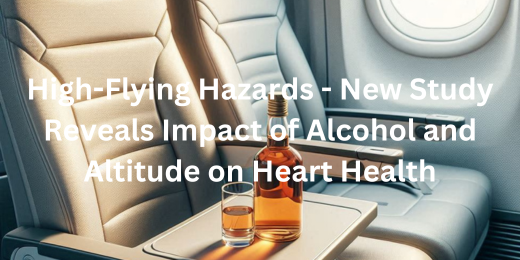
High-Flying Hazards – New Study Reveals Impact of Alcohol and Altitude on Heart Health
Effects of Alcohol on Blood Oxygen Levels During Long-Haul Flights
The combination of in-flight alcohol and heart health is a concern for passengers, particularly during long-haul flights. Drinking alcohol at high elevations can lower blood oxygen saturation (SpO2) levels considerably. This effect is more pronounced during sleep, with levels dropping to an average of just over 85%. This article builds upon the information presented in the BMJ Post.
Such prolonged low oxygen levels pose significant risks, especially for older passengers and those with pre-existing conditions. The long-haul flight risks of alcohol are not limited to decreased oxygen levels. Alcohol also increases the heart rate, which can lead to further complications during extended periods of low oxygen availability.
The effects of in-flight alcohol and heart health are compounded by the cabin pressure at cruising altitude, creating a more challenging environment for the body. The combined impact on SpO2 levels and heart rate underscores the long-haul flight risks of alcohol, making it essential to consider limiting alcohol consumption during flights. This is particularly important for vulnerable groups such as the elderly and individuals with health issues.
Impact on Heart Rate and Sleep Quality
The combination of in-flight alcohol and heart health affects sleep quality significantly. Alcohol consumption and cabin pressure increase the heart rate to nearly 88 beats per minute during sleep. With this combo, deep sleep (N3 stage) lasts only 46.5 minutes.
Additionally, the long-haul flight risks of alcohol include shorter REM sleep duration. Rapid Eye Movement or REM sleep is a unique stage of the sleep cycle marked by increased brain activity, vivid dreams, and fast eye movement. It is essential for mental processes including regulating emotions and consolidating memories. REM sleep is crucial for the recuperative stages of sleep, impacting overall rest and health. Reduced deep and REM sleep can leave passengers feeling less refreshed and more fatigued after a flight.
Prolonged exposure to in-flight alcohol and heart health risks may have long-term effects on passengers. The combined impact on heart rate and sleep quality underscores the long-haul flight risks of alcohol. Understanding these effects is important for promoting healthier travel practices.
Comparative Analysis: Sleep Lab vs. Altitude Chamber
The study compared sleep lab conditions to an altitude chamber to assess the impact of in-flight alcohol and heart health. In the sleep lab without alcohol, SpO2 and heart rate were significantly better. This suggests a controlled environment supports healthier heart and oxygen levels.
In the high-altitude compartment with no alcohol, heartbeats were below 73 pumps every minute and the levels of SpO2 were little above 88%. This highlights the long-haul flight risks of alcohol, as alcohol further exacerbates hypobaric hypoxia effects. High elevations cause the body to be more taxed because of lower oxygen levels and faster heart rates.
Alcohol consumption in an altitude chamber worsens sleep quality and increases cardiac strain. These findings emphasise the importance of understanding the long-haul flight risks of alcohol. Considering these effects can help in promoting better health and safety practices during flights.
Implications for Older Passengers and Those with Health Conditions
The combination of in-flight alcohol and heart health is particularly concerning for older passengers and those with cardiac or pulmonary diseases. These individuals face higher risks due to the combined effects of alcohol and cabin pressure. Such conditions can significantly strain the heart and exacerbate existing health issues.
Cardiac arrests account for 58% of aircraft diversions, while cardiovascular symptoms are common in 7% of in-flight medical crises. This underscores the long-haul flight risks of alcohol for passengers with underlying health conditions. It is crucial to consider these risks to ensure passenger safety.
The strain on the cardiac system from in-flight alcohol and heart health risks can lead to serious health complications. Understanding the long-haul flight risks of alcohol helps in making informed decisions about alcohol consumption during flights. This awareness is vital for the health and safety of vulnerable passengers.
Recommendations for Inflight Alcohol Consumption
Researchers recommend rethinking the accessibility of alcohol on long-haul flights to address concerns related to in-flight alcohol and heart health. This is important due to the combined effects of alcohol and cabin pressure on passengers’ health. Limiting alcohol availability may help reduce these risks.
Informing passengers, practitioners, and crew about the potential health risks is crucial. Awareness can significantly mitigate the long-haul flight risks of alcohol. By understanding these dangers, passengers can make better choices and safeguard their health during long-haul flights.
Restricting alcohol consumption could alleviate health risks associated with reduced oxygen levels and increased heart rates. These measures aim to enhance in-flight alcohol and heart health safety. Implementing these recommendations can promote healthier and safer travel for all passengers, particularly those with pre-existing conditions.
Future Research and Study Limitations
The study acknowledges its small sample size and specific conditions that may not reflect the general population. This limitation points to the necessity of more comprehensive research. Expanding the sample size can provide a clearer understanding of in-flight alcohol and heart health.
Further research is needed to validate findings across a broader demographic, including economy class passengers. This broader approach can help in better assessing the long-haul flight risks of alcohol for different groups. It is essential to consider various passenger categories for more accurate results.
The study highlights the need for continued investigation into inflight health and safety measures. Ongoing research can improve guidelines for in-flight alcohol and heart health. By addressing these aspects, the aviation industry can enhance passenger safety and well-being during flights.